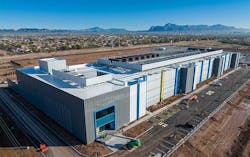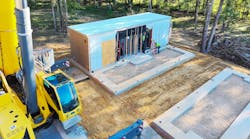NTT Redefines Sustainable AI Infrastructure with $16.4B NTT Data Buyout, Global Data Center Expansion Blitz
NTT is taking bold steps to reshape its global data infrastructure footprint to meet the escalating demands of AI and cloud computing, announcing a $16.4 billion buyout of its publicly traded IT services arm, NTT Data, while also accelerating global data center development with nearly a gigawatt of new capacity planned across strategic markets.
The moves are part of a sweeping strategy to consolidate control, streamline decision-making, and invest proactively in next-generation infrastructure to support high-performance digital workloads. Combined with a robust sustainability push and a $10 billion capital plan through 2027, NTT is signaling its intent to be a dominant force in the AI-powered digital economy.
NTT to Take NTT Data Private in $16.4 Billion Move
On May 8, NTT Corp. announced it will take full ownership of NTT Data in a deal valued at 2.37 trillion yen ($16.4 billion), marking one of the largest tech privatizations in Japan in recent years. The Tokyo-based telecom giant will acquire all remaining outstanding shares of NTT Data—currently Japan’s largest IT services provider—at 4,000 yen ($27.65) per share, representing a 34% premium over the previous day’s closing price.
Following a Nikkei report ahead of the announcement, NTT Data’s shares hit their daily limit high of 3,492 yen on a flood of buy orders and were untraded on the Tokyo Stock Exchange the day of the news.
NTT currently owns 57.7% of NTT Data, which has a market capitalization of $29.5 billion as of the prior day’s close. By launching a full tender offer, NTT aims to simplify its sprawling corporate structure and streamline decision-making—especially as it pivots aggressively toward AI, mobility platforms, and next-generation communications technologies such as photonics.
The move echoes NTT’s 2020 buyout of its mobile carrier arm, NTT Docomo, in a 4 trillion yen deal, underscoring a broader trend of parent-child consolidations among Japanese conglomerates. Analysts say such restructurings aim to eliminate inefficiencies and better position firms for fast-moving technology shifts and global competition.
NTT Data traces its roots to 1967 as a division of the Japan Telegraph and Telephone Public Corporation, the forerunner to NTT. It spun out as a standalone entity in 1988 and has since become a global powerhouse, operating over 150 data centers in 20 markets and delivering critical IT and digital transformation services to enterprise and government clients worldwide.
By reintegrating NTT Data, NTT gains tighter alignment between its cloud, data center, and IT services operations—an increasingly vital synergy as enterprise clients ramp up AI adoption and digital infrastructure becomes a strategic competitive advantage.
“Taking NTT Data private accelerates our ability to deliver integrated, AI-powered solutions across our entire platform,” the company said in its statement.
The privatization also reinforces NTT’s stature as a global data infrastructure heavyweight—one that is vertically aligning to deliver not only scalable capacity but also embedded intelligence, platform services, and emerging mobility and communications applications.
Global Expansion Adds Nearly 1GW in New Capacity
Only days after announcing the buyout, NTT Data revealed an ambitious expansion of its Global Data Centers division, securing land across seven key global markets for future development totaling nearly a gigawatt of capacity.
“By bringing new capacity to high-growth regions, we’re building the foundation enterprises need to innovate, scale and lead confidently in an AI-driven economy,” said Doug Adams, CEO and President of Global Data Centers, NTT Data. “With the backing of our parent company, we are uniquely positioned to invest and build proactively, ahead of market demand.”
The newly announced land acquisitions span both new and existing markets:
New Markets
- Milan, Italy: A 53-acre site will host a 128MW facility, marking NTT’s entry into the Southern European market amid rising demand for hyperscale and AI-ready infrastructure.
- Tochigi, Japan: In the Tochigi Inter Industrial Park near Tokyo, NTT has acquired 32 acres to build two data centers totaling approximately 100MW.
Expanded Presence in Existing Markets
- Hillsboro, Oregon: New land will support an additional 216MW, bringing the Hillsboro market total to 354MW. The site will benefit from direct Asia connectivity via NTT’s Subsea Connect network.
- Mesa, Arizona: A 174-acre acquisition will anchor a new campus featuring seven facilities with a combined capacity of 324MW, supplementing an existing 240MW campus nearby.
- London, England: A new 26.3-acre development (LON2) and freehold acquisitions reinforce NTT’s position in one of the world’s most active interconnection hubs.
- Frankfurt, Germany: The company’s fifth site in Frankfurt will add 80MW, further anchoring NTT in a top-tier European cloud and enterprise market.
- Osaka, Japan: Two new data centers totaling 36MW will raise the company’s Osaka region footprint to 70MW across three facilities.
“These land acquisitions are about more than growth; they’re about shaping the future of digital infrastructure on a global scale,” said Adams.
Sustainability Commitments Drive Greener AI Infrastructure
In a separate milestone, NTT Global Data Centers published its first annual sustainability report in April, detailing its progress toward Net-Zero operations and highlighting innovations that align with the environmental demands of large-scale digital infrastructure.
In FY23, the company achieved 51% renewable energy usage for non-IT load globally and secured 1.7 TWh of renewable energy through power purchase agreements. NTT’s goal is to achieve Net-Zero emissions across Scope 1 and 2 by 2030, and full Scope 1–3 by 2040—ten years ahead of the Paris Agreement target.
“Sustainable digital infrastructure isn’t just a goal — it’s an imperative,” Adams said. “As AI and digital transformations accelerate, we are committed to integrating smarter energy solutions, advanced technologies, and AI-driven efficiencies to reduce our environmental impact at scale.”
Highlights from NTT’s global sustainability initiatives include:
- Germany: A 2MW waste heat reuse project in Berlin now provides heating to over 1,000 buildings, with future plans to expand to 37MW (more on this below). A new 8MW heat recovery project has also been announced for a nearby residential district.
- United Kingdom: Implementation of reverse osmosis filtration has reduced annual water usage by 35,000m³, saving $120,000 annually. Smart sensor upgrades have cut fan energy use by 50%, saving 2.6 GWh annually.
- Mumbai, India: Liquid immersion and direct contact cooling technologies are improving energy efficiency by 30%, critical for AI workloads.
The sustainability report also outlines future efforts to scale these initiatives, including enhanced heat reuse, circular economy strategies, and deeper integration of AI into facility operations.
From AI Ecosystem to Agentic Architecture: NTT DATA Builds Toward Autonomous Outcomes
NTT’s next move builds on the momentum of its foundational AI and data center strategy, revealing a future where intelligent automation becomes core infrastructure. In May, NTT DATA unveiled its Smart AI Agent™ Ecosystem, a sweeping portfolio of agentic AI offerings designed to transform industries with embedded, outcome-driven intelligence.
These products aren’t merely language models or chat-based copilots — they are self-directed software agents that make decisions, collaborate with human stakeholders, and interface directly with real-world business systems.
The new ecosystem spans verticalized agent solutions across healthcare, finance, manufacturing, logistics, and marketing.
In healthcare, for example, NTT’s Smart AI Agents are already triaging insurance claims and identifying fraud in real-time — while in automotive manufacturing, agents proactively analyze defect reports and initiate corrective actions, transforming reactive compliance into predictive assurance.
Crucially, this next phase of AI infrastructure isn’t confined to new builds. NTT DATA also announced a patented plug-in solution that retrofits existing RPA bots — once static rule-followers — into autonomous intelligent agents. This means enterprises don’t need to rip and replace legacy systems. Instead, they can breathe new life into them, essentially upgrading their digital workforce to function more like a cognitive one.
Spanning the Clouds Alongside OpenAI
Underpinning this approach is a growing Agentic AI Services platform, already orchestrating multi-agent workflows across cloud environments from Microsoft Azure, AWS, and Google Cloud. NTT DATA’s strategic collaboration with OpenAI further reinforces its commitment to operationalizing AI, with a new Center of Excellence designed to accelerate industry-specific generative and agentic deployments.
The takeaway is clear: where once AI supplemented human effort, NTT’s agentic vision pushes toward cooperative autonomy — a paradigm where human-machine teams continuously optimize business operations in real time.
Carbon-Free Heat and Intelligent Waste: Data Centers Become Part of the Urban Fabric
If the Smart AI Agent ecosystem illustrates how NTT is redefining the function of digital infrastructure, a further recent announcement from the company's Global Data Centers division shows how the company is reimagining its footprint.
In April, NTT DATA disclosed one of Germany’s most ambitious data center waste heat recovery projects, repurposing thermal energy from two existing Spandau data centers to sustainably heat Berlin’s new 76-acre “Das Neue Gartenfeld” district.
The project, a collaboration with ENGIE Deutschland and GASAG Solution Plus, will supply up to 8 megawatts of heat capacity to more than 10,000 residents — a direct-to-community deployment of otherwise wasted energy. While the concept of using data center heat isn’t new, what’s significant is that this project retrofits existing infrastructure — not just new, purpose-built facilities — and does so at an urban district scale.
“This is likely the largest waste heat recovery project in Germany from existing data centers,” said Konstantin Hartmann, Managing Director EMEA for NTT Global Data Centers. “It proves that carbon-free heat at 20 to 30 degrees Celsius can be sustainably used for real-world applications — not just theoretical pilots.”
Construction on the energy center begins in 2026, but the project’s strategic implications are already here. As generative and agentic AI workloads drive exponential growth in thermal density, NTT’s approach suggests a future where data centers become decentralized energy hubs, actively participating in local climate strategy rather than merely mitigating their impact.
Together, these initiatives as recounted above — from multi-agent AI platforms to urban-scale heat reuse — reinforce NTT’s core thesis: the data center of the future isn’t just where compute happens. It’s where intelligence lives, energy flows, and infrastructure becomes inseparable from human systems.
Positioning for AI and the Future of Infrastructure
With a growing global footprint, a vertically integrated strategy, and a massive investment plan, NTT is positioning itself to become an indispensable player in the infrastructure that underpins AI and digital transformation.
As the world’s third-largest data center operator, NTT Global Data Centers added 10 new facilities and more than 370MW of capacity in the past year alone. Its $10 billion capital commitment through 2027 will continue fueling both geographic expansion and technology innovation.
“We believe technology and environmental stewardship must go hand in hand,” Adams said. “Driven by innovation and a bold vision for the future, we are reimagining what’s possible for a sustainable, more resilient digital world.”
With the full integration of NTT Data into its corporate structure and a sharp focus on building at hyperscale, NTT’s strategy reflects a broader shift across the industry—where infrastructure is not only growing fast but becoming smarter, greener, and more central to the global digital economy.
At Data Center Frontier, we talk the industry talk and walk the industry walk. In that spirit, DCF Staff members may occasionally use AI tools to assist with content. Elements of this article were created with help from OpenAI's GPT4.
Keep pace with the fast-moving world of data centers and cloud computing by connecting with Data Center Frontier on LinkedIn, following us on X/Twitter and Facebook, as well as on BlueSky, and signing up for our weekly newsletters using the form below.
About the Author
Matt Vincent
A B2B technology journalist and editor with more than two decades of experience, Matt Vincent is Editor in Chief of Data Center Frontier.



